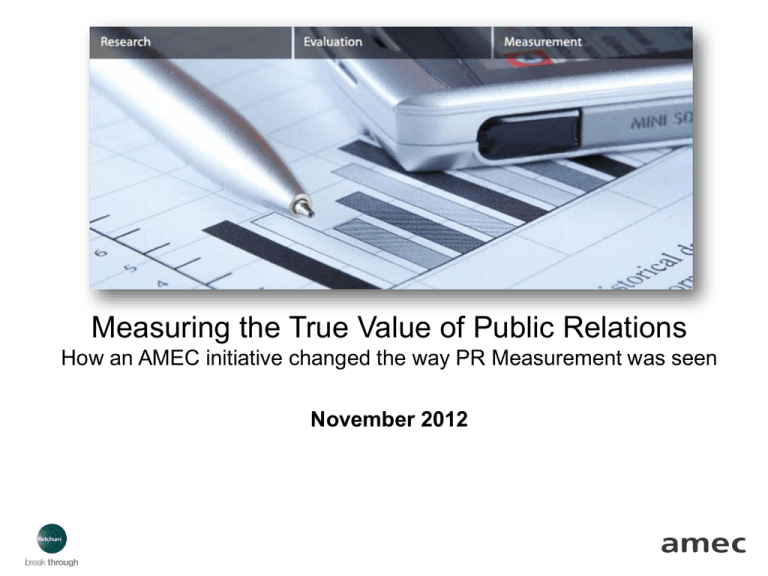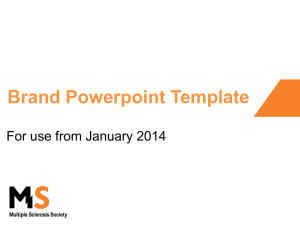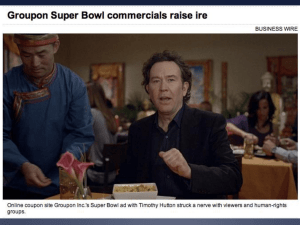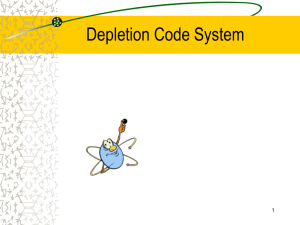Measuring the True Value of Public Relations Presented to
advertisement

Measuring the True Value of Public Relations How an AMEC initiative changed the way PR Measurement was seen November 2012 Seven Principles of PR Measurement 1. Importance of Goal Setting and Measurement 2. Measuring the Effect on Outcomes is Preferred to Measuring Outputs 3. The Effect on Business Results Can and Should Be Measured Where Possible 4. Media Measurement Requires Quantity and Quality 5. AVEs are not the Value of Public Relations 6. Social Media Can and Should be Measured 7. Transparency and Replicability are Paramount to Sound Measurement Measuring communications on three impact levels Outputs Contact/response level Reach, content Frequency Visits Prominence Reader contacts Tonality Message impact Share of voice Journalist inquiries … Impact on media/channels Outcomes Perception/ behavioral level Knowledge, opinions, attitudes Business Results Awareness Comprehension Recollection Recognition Credibility Image changes Recommendations Purchasing intentions ... Revenue/turnover Contracts closed Reputation value Brand value Price-Effort Ratio Market share Stock price Employee Retention ... Impact on target groups Impact on organizations Business level Added value Output Focused Clients Clips Count. Media Results -- Approach Overall clip counts and general impressions are usually meaningless Media analyses, whether of traditional or online channels, should focus on the quality of the media coverage Goal-definition and benchmarking are vital for robust results and to track changes over time Experimenting and testing are potentially successful approaches, for example in the development of (new) key figures/ indicators Clips Have to be Good. Outcome Focused Client They Do Something Different. They Like Me. Use of online/offline surveys in communications processes Market and Opinion research – Aims Basis for communications Providing important information about relevant target groups Input for communications Generation of topics and content for press releases Control of communications Evaluation of long-term effects of PR activities Organizational Results Focused Client Money Matters. Set Goals First Before Measuring Communications Communications Goals Reach Awareness Comprehension Attitude Behavioral Awareness Knowledge Consideration Preference Action Brand/ Product Marketing Public Relations Activity Intermediary Effect Target Audience Effect • • • • • • Content creation Traditional media engagement Social media engagement Influencer engagement Stakeholder engagement Events/speeches • Audience reach [traditional & social media] • Impressions/Target audience impressions • Number of articles • Video views • Frequency • Prominence • Share of voice • Key message alignment • Accuracy of facts • Key message alignment • Frequency of (positive) mentions • Expressed opinions of consideration • Social network Followers • Retweets/Shares/ Linkbacks • Endorsement by journalists or influencers • Rankings on industry lists • Expressed opinions of preference • Social network Fans • Likes • Unaided awareness • Aided awareness • Knowledge of company/prod uct attributes and features • Brand association and differentiation • Relevance of brand (to consumer/ customer) • Visitors to website • Click-thru to site • Time spent on site • Downloads from site • Calls • Event/meeting attendance • Attitude uplift • Stated intention to buy • Brand preference/ Loyalty/Trust • Endorsement • Requests for quote • Links to site • Trial • • • • Sales Market share Cost savings Leads generated • Customer loyalty 9 Communications vs. evaluation goals Corporate goals What is the overarching business goal that is to be supported by communications? What are the desired (measurable) changes in the target group as the result of communications? Communication goals Coverage: Number of articles in target group (media), penetration of messages Perception: Brand awareness, recollection of topics Evaluation goals Comprehension: Credibility of content, connection to company Attitude: Brand loyalty, increased employee motivation Behavior: Purchase decisions, project involvement Measurable criteria Who? What? How much? By when? Goals should be defined as quantitative as possible Sample Goals in Need of Some Work Drive media coverage (food and lifestyle), product awareness and trial by building consumer buzz Shape the bleach dialogue online Change the perception from a company that makes computers to a company that is a leader in global business solutions Bank Card: – Create “card envy” among affluent consumers in the San Francisco market – Raise awareness that this card offers cardmembers unique experiences, not just more ‘stuff’ Eyeglasses: – Raise awareness around lens choice and that eyeglass lens choice exists with mid-to-late GenXers, 40 – 45 years old Vodka Nightlife Exchange Project: – Set emotional connection with consumers (consideration) – Reinforces “Nightlife experts” credentials – Key to Lead digital agenda in Brazil Sample Goals That Are Easy to Measure 2011 internal comms plan : • Achieve 65% strategy comprehension in top 3 boxes on pulse survey(s) • Create and execute managers strategy toolkit; achieve 55% manager participation • Increase Inside site traffic by 15% (from 70% base to 85%) Randomize 180 patients for a juvenile fibromyalgia study by October 24, 2012. Contribute 40% of the global patients enrolled in a diabetic peripheral neuropathic pain study by September 30, 2011. Refer 60 pre-qualified participants for an epilepsy study by the end of 2011. Increase the image of PRSA among lapses members from 6.0 to 7.0 by the end of 2012. Measure Media Quantity and Quality, Not AVEs AVE: History & Use • For many years, PR professionals struggled to assign a value to clips. This led to Advertising Value Equivalency (AVE) or valuing clips as paid advertisements. • Essentially, an AVE places a monetary value on a public relations placement by using the dollar amount paid for an equivalent advertising space. – Less commonly known as Advertising Cost Equivalent (ACE) or Advertising Space Equivalent (ASE). Why all the fuss about AVEs? – A Discussion PR Placement Paid Advertisement Ad Cost: $100,000 = AVE Cost: $100,000 Why Ban AVEs? • • • • • Cannot capture the outcome of a PR campaign, limiting PR to its placements in the media. Cannot measure the variety of messages delivered in the media in relation to the tamed messages in advertisements. Cannot measure the value of keeping a client out of the media spotlight. Cannot properly distinguish between placements in noteworthy columns or sections of a publication and generic or less desirable areas of a publication. Cannot measure social media forms, such as blogs and message boards. •Because an AVE is the Cost of Advertising, •Not the Value of Earned Media Media results – Approach Overall clip counts and general impressions are usually meaningless Media analyses, whether of traditional or online channels, should focus on the quality of the media coverage Goal-definition and benchmarking are vital for robust results and to track changes over time Experimenting and testing are potentially successful approaches, for example in the development of (new) key figures/ indicators Traditional media Social media Circulation, reach Visits, fans, followers Share-ofvoice Active advocates Tonality Sentiment ratio ‘Message’ penetration Audience engagement What Good Media Analysis Looks Like: Philips March February Monthly Net Change (+/-) Total # of impressions 285 216,899,003 234 198,840,298 51 18,058,705 AMS (from -100 to 100) 51.43 60.96 -9.53 Net Promoter Score (NPS)* 7.57 8.05 -0.48 Message Penetration (% with 2+ messages) 68.4% 51.5% 16.9% Tone (positive coverage) 54.0% 65.0% -11% Total # of articles Social Media Can and Should be Measured Social Media: Monitoring vs. Measuring • Monitor – Look for issues to which your organization or brand might want to react – Identify trends in consumer opinion, desired content/features, etc. – Provide a qualitative analysis of content • Measure – Quantify reach, tone, recommendations, etc. – Identify top users – Benchmark in advance of interactive activity to track changes over time Outcomes Are Better Than Outputs Market and Opinion Research – Aims Use of online/offline surveys in communications processes Basis for communications Providing important information about relevant target groups Input for communications Generation of topics and content for press releases Control of communications Evaluation of long-term effects of PR activities Guns N’ Roses and Dr Pepper Results Source of Awareness of Guns N’ Roses & Dr Pepper Promotion Aware of Guns N’ Roses – Axl Rose Album Release Dr Pepper Promotion Aware of Promotion Unaware of Promotion 21% 18% 6% 18% 9% 6% 6% 94% Radio Unaided Awareness for Dr Pepper was 48% [Other 6% and Don’t Know 45%] 0% Quite Negative 3% Dr Pepper Coca-Cola Mountain Dew TV Other 3% 39% 21% 37% Somewhat Negative Neither Positive nor Negative Somewhat Positive Quite Positive 15% 6% Magazine Newspaper Attitude Effect of on Dr Pepper due to promotion Aided Brand Awareness of Promotion 61% Internet 3% Fanta None In General those aware felt somewhat/very positive about the promotion. Those who did not remained neutral. There was very little to no negative impact caused by this promotion. Overall, it shed a positive light on the brand. Base Sizes: Those Asked (n=539), Those Aware of Promotion (n=33d) d = directional findings only (30-40) Corporate Brandbuilder – Dow “Human Element” Media Matters Communications Exposure Reputation Score None Average Advertising Media Internet Brand Equity +25% Stock Price +29% Prioritizing Drivers By Country: Hypothetical Example • In addition to shared key drivers, individual countries can have drivers specific to their market. – For example, in the UK, it is critical to demonstrate employee engagement and a management commitment. US UK Product Development Employee and Supplier Engagement General Transparency Innovation Regulatory France Product Development Innovation Recycling & Waste Reduction Energy Conservation Carbon Emissions & Pollution Reduction Regulatory Risk Management Germany Product Development Innovation Management Commitment Management Commitment Spain Product Development Safety General Product/Service Quality Risk Management Business Results Are Better Than Outcomes: The Trend Toward Analytics Modeling – Aims Objective: To analyze influences on the trend in business results, taking into account all tools for communication What is the impact on company results generated by specific communications measures? What is the optimal communications budget (ROI) in order to achieve the company’s target? What media mix has the greatest effect on brand awareness? Which products in the portfolio drive sales best? Shall communication activities be planned parallel to competition or alternate? Which communications strategy is most successful? Analytics: What Makes A Good Model? • The way you judge a good statistical model is by what percentage of the variance can be described by it. In regression, R² is the statistic that represents “goodness-of-fit “ or how well the regression line approximates the real data points. An R² of 1.0 indicates that the regression line perfectly fits the data. Sales • PR Spend Source: Center Parcs Germany, own calculations Sep/ 07 Aug/ 07 Jun/ 07 Jul/ 07 Mai/ 07 Apr/ 07 Feb/ 07 Mrz/ 07 Jan/ 07 Dez/ 06 Nov/ 06 Okt/ 06 Sep/ 06 Aug/ 06 Jul/ 06 Jun/ 06 Mai/ 06 Apr/ 06 Feb/ 06 Mrz/ 06 Jan/ 06 Nov/ 05 Dez/ 05 Sep/ 05 Okt/ 05 Aug/ 05 Jul/ 05 Jun/ 05 Mai/ 05 Apr/ 05 Feb/ 05 Mrz/ 05 PR circulation bookings 9,000,000 6,000,000 3,000,000 0 PR circulation Jan/ 05 Bookings Center Parcs – Bookings vs. PR circulation 15,000,000 12,000,000 Center Parcs – High Adjustment of the Bookings Model Bookings Bookings R² = 0,86 Jan/ Mrz/ Mai/ Jul/ Sep/ Nov/ Jan/ 05 05 05 05 05 05 06 Source: Center Parcs Germany, own calculations Mrz/ 06 Mai/ 06 Jul/ 06 Sep/ 06 Nov/ 06 Jan/ 07 Mrz/ 07 Mai/ 07 Jul/ 07 Sep/ 07 Center Parcs – Effects on Sales (Bookings) PR circulation 3% TV 6% Direct Mailings 7% Magazines 10% Magazines 1% Baseline 34% Winter catalogue 6% Summer catalogue 8% TV 60% Price 13% basic sales: 56% (baseline + seasonality) Seasonality 22% Source: Center Parcs Germany, own calculations mass media: 10% (Benchmark: 5 – 20%) PR circulation 30% CPG Company: Sales Modeling Volume Decomposition: (May 2008 – Apr 2010) 300,000 275,000 225,000 Online Media MAT Release 200,000 Line Extension PR In-Store Coupon 175,000 PR In-Pack Coupon Shelftalk 150,000 FSI New Packaging lift 125,000 TV Trade Merchandising 100,000 Base Volume 75,000 Chart data reflects estimated volume from the sum of 65 DMAs 4/4/2010 3/7/2010 2/7/2010 1/10/2010 12/13/2009 11/15/2009 10/18/2009 9/20/2009 8/23/2009 7/26/2009 6/28/2009 5/31/2009 50,000 5/3/2009 Ttl Healthy Choice Frozen SSM Sales (CSU) 250,000 CPG Company: Sales Modeling Calculating the impact of marketing elements on sales in 2 ways: A Direct Marketing Mix Model (ROMI) Marketing Elements Sales Impact A Two-Stage Model Marketing Elements Website model Website Visits Residual model Sales Impact (residual) Non-Profit: Optimal Marketing Mix for Leads • Comparing the effectiveness of direct mail, radio advertising, online activity, and two forms of Point of Purchase materials Channel Dollars Spent Total (Annual) Leads* Generated Per $1,000 Total Leads Generated (Annual) Direct Mail $8.5 mi 7 59,747 Radio $930K 5 4,645 Online $189K 33 6,249 PoP H $ 227K 10 2,270 PoP P $472K 23 11,126 R2 = .668 Model 1:Leads § = 96.51 + 0.007(Direct Mail )+ 0.005(Radio) + 0.033(Online) + .010(PoP H) + .023(PoP P) + 136(If summer) +168(If fall) §Significant at p > 0.05 (2-sided) Non-Profit: What Happens If There is a Shift in Point of Purchase Programs? • If professional PoP outreach is used for all annual PoP marketing spend instead of ever using a hodgepodge approach, potential revenue increase is $8.2 million $ Shifted from PoP H to PoP P Net Leads Gained Potential Increase in Revenue $226,983 2,951 $8.2 million The 10 Golden Rules of Measurement 1. Establish written goals 2. Measure the quantity and quality of media 3. Understand the same principles apply to traditional and social media 4. Do not use AVE as the value of PR 5. Add PR questions to tracking surveys to easily capture outcomes 6. Collect media data in a manner usable for market mix modeling 7. Recognize that analytics is the future of PR measurement—ROI is the answer 8. Make sure all measurement is transparent 9. Use measurement to track progress and to design programs better 10. Realize that communications experts are not necessarily measurement experts Thank you!










